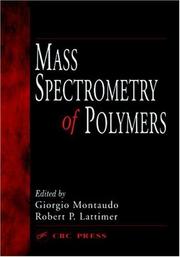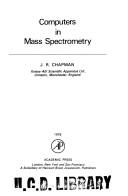| Listing 1 - 10 of 31 | << page >> |
Sort by
|
Book
Year: 1965 Publisher: Bruxelles : Vaillant-Carmanne,
Abstract | Keywords | Export | Availability | Bookmark
 Loading...
Loading...Choose an application
- Reference Manager
- EndNote
- RefWorks (Direct export to RefWorks)
Book
Year: 1967 Publisher: Liège : Université de Liège, Faculté des sciences (ULg),
Abstract | Keywords | Export | Availability | Bookmark
 Loading...
Loading...Choose an application
- Reference Manager
- EndNote
- RefWorks (Direct export to RefWorks)
Book
Year: 1968 Publisher: New York, NY : Interscience Publishers, a division of John Wiley & Sons,
Abstract | Keywords | Export | Availability | Bookmark
 Loading...
Loading...Choose an application
- Reference Manager
- EndNote
- RefWorks (Direct export to RefWorks)
Book
Year: 1971 Publisher: Oxford : Pergamon Press,
Abstract | Keywords | Export | Availability | Bookmark
 Loading...
Loading...Choose an application
- Reference Manager
- EndNote
- RefWorks (Direct export to RefWorks)
Book
ISBN: 9789814774772 9781351207157 Year: 2018 Publisher: Singapore : Pan Standford Publising,
Abstract | Keywords | Export | Availability | Bookmark
 Loading...
Loading...Choose an application
- Reference Manager
- EndNote
- RefWorks (Direct export to RefWorks)
It is estimated that there are about 10 million organic chemicals known, and about 100,000 new organic compounds are produced each year. Some of these new chemicals are made in the laboratory and some are isolated from natural products. The structural determination of these compounds is the job of the chemist. There are several instrumental techniques used to determine the structures of organic compounds. These include NMR, UV/visible, infrared spectroscopy, mass spectrometry, and X-ray crystallography. Of all the instrumental techniques listed, infrared spectroscopy and mass spectrometry are the two most popular techniques, mainly because they tend to be less expensive and give us the most structural information.This book is an introductory text designed to acquaint undergraduate and graduate students with the basic theory and interpretative techniques of mass spectrometry. Much of the material in this text has been used over a period of several years for teaching courses in materials characterization and chemical analysis. It presents the mass spectra of the major classes of organic compounds and correlates the fragmentation pattern of each spectrum with the structural features of the compound it represents. This has been done for hydrocarbons, organic acids, ketones, aldehydes, esters, anhydrides, phenols, amines, and amides. The text discusses the origin of the fragments, techniques, innovations, and applications in mass spectrometry. It is interspersed with many illustrations, examples, an adequate but not overwhelming bibliography, and problems for students. It will serve as a lecture text for a one-semester course in mass spectrometry or can be used to teach the mass spectra portion of a broader course in material characterization and chemical analysis.
Book
ISBN: 0824714628 Year: 1970 Publisher: New York : Marcel Dekker,
Abstract | Keywords | Export | Availability | Bookmark
 Loading...
Loading...Choose an application
- Reference Manager
- EndNote
- RefWorks (Direct export to RefWorks)
Mass spectrometry --- Anions --- Spectroscopie de masse. --- Anions.

ISBN: 9780367455095 9780849331275 9780429119712 Year: 2019 Publisher: Boca Raton, FL : CRC Press,
Abstract | Keywords | Export | Availability | Bookmark
 Loading...
Loading...Choose an application
- Reference Manager
- EndNote
- RefWorks (Direct export to RefWorks)
Mass Spectrometry (MS) has rapidly become an indispensable tool in polymer analysis, and modern MS today complements in many ways the structural data provided by Nuclear Magnetic Resonance (NMR) and Infrared (IR) methods. Recent advances have sparked a growing interest in this field and established a need for a summary of progress made and results achieved.Mass Spectrometry of Polymers effectively fills this need. The discussion begins by introducing MS in detail, providing a historical perspective and a review of modern instrumentation and methods. The text then focuses on mathematical concepts and practical algorithms used in some of the major quantitative polymer applications of MS, providing a skillful prologue to polymer characterization techniques. Detailed chapters follow, describing the most relevant applications of MS to the analysis of polymers and the techniques currently employed.Authored by internationally recognized experts from academia and industry, Mass Spectrometry of Polymers is the only state-of-the-art work available that deals systematically with this rapidly emerging discipline, and will be useful to both novices and experienced practitioners in polymer MS.
Polymers --- Mass spectrometry. --- Polymères --- Spectroscopie de masse. --- Analysis. --- Analyse.

ISBN: 0121687503 Year: 1978 Publisher: London
Abstract | Keywords | Export | Availability | Bookmark
 Loading...
Loading...Choose an application
- Reference Manager
- EndNote
- RefWorks (Direct export to RefWorks)
fysicochemie --- Computer. Automation --- Organic spectroscopy --- Mass spectrometry --- Spectroscopie de masse --- Data processing --- Informatique --- Informatique.
Book
ISBN: 9780367868581 9781466597563 9781315316208 Year: 2019 Publisher: Boca Raton : CRC Press, Taylor & Francis Group,
Abstract | Keywords | Export | Availability | Bookmark
 Loading...
Loading...Choose an application
- Reference Manager
- EndNote
- RefWorks (Direct export to RefWorks)
This detailed handbook covers different chromatographic analysis techniques and chromatographic data for compounds found in air, water, and soil, and sludge. The new edition outlines developments relevant to environmental analysis, especially when using chromatographic mass spectrometric techniques. It addresses new issues, new lines of discussion, and new findings, and develops in greater detail the aspects related to chromatographic analysis in the environment. It also includes different analytical methodologies, addresses instrumental aspects, and outlines conclusions and perspectives for the future
Chromatographic analysis. --- Mass spectrometry. --- Environmental chemistry. --- Chromatographie --- Chimie de l'environnement --- Spectroscopie de masse.
Book
ISBN: 9781119964001 Year: 2013 Publisher: Chichester : Wiley,
Abstract | Keywords | Export | Availability | Bookmark
 Loading...
Loading...Choose an application
- Reference Manager
- EndNote
- RefWorks (Direct export to RefWorks)
This book provides all the necessary knowledge about mass spectrometry based proteomics methods and computational and statistical approaches to pursue the planning, design and analysis of quantitative proteomics experiments. The author's carefully constructed approach allows readers to easily make the transition into the field of quantitative proteomics. Through detailed descriptions of wet-lab methods, computational approaches and statistical tools, this book covers the full scope of a quantitative experiment, allowing readers to acquire new knowledge as well as acting as a useful reference work for more advanced readers.
Mass spectrometry. --- Proteomics --- Spectroscopie de masse --- Protéomique --- Biostatistiques. --- Statistical methods.
| Listing 1 - 10 of 31 | << page >> |
Sort by
|

 Search
Search Feedback
Feedback About UniCat
About UniCat  Help
Help News
News